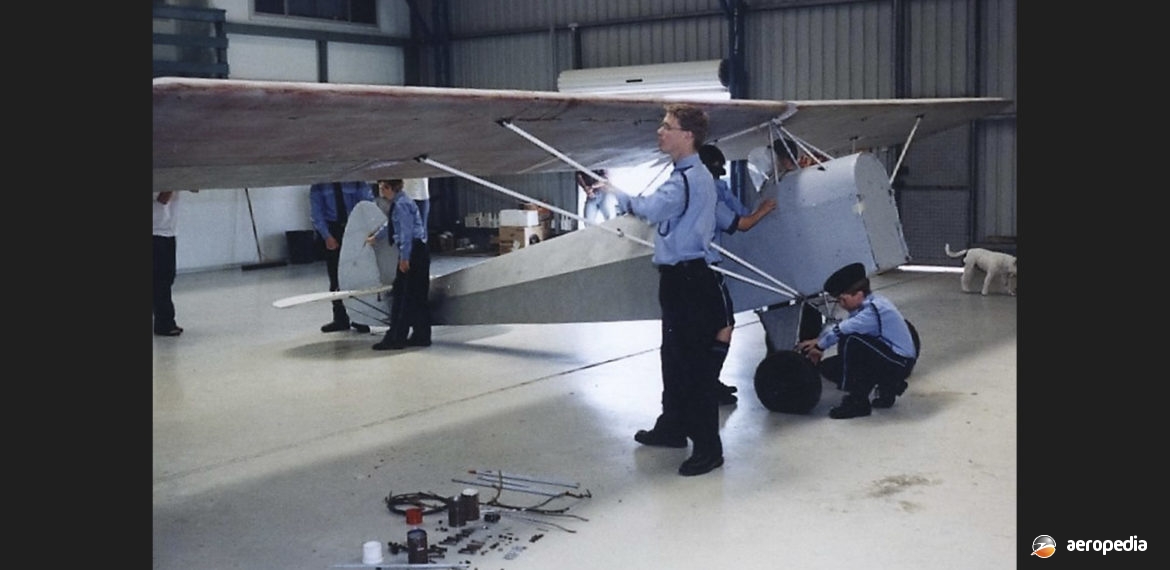Photograph:
Longster with the Coffs Harbour Australian Air League Squadron, NSW (N Lawson)
Country of origin:
United States of America
Description:
Single-seat light parasol-wing sport aircraft
Power Plant:
One 22.3 kw (30 hp) Long Harlequin two-cylinder horizontally-opposed air-cooled engine
Specifications:
- Wingspan: 9.17 m (30 ft 1¼ in)
- Length: 5.48 m (18 ft)
- Max speed: 121 km/h (75 mph)
- Landing speed: 40 km/h (25 mph)
- Empty weight: 147 kg (325 lb)
- Loaded weight: 261 kg (575 lb)
History:
The Longster was a single-seat light parasol-wing aircraft designed for amateur constructors in the late 1920s by the Long Brothers who operated a radio factory in Cornelius, Oregon. Their first design left much to be desired and they abandoned it. They then built the Anzani Longster in 1930, this being a single-seat shoulder-wing monoplane with a 26 kw (35 hp) Anzani radial engine. This was developed to the Longster III, this being a high-wing monoplane originally powered by a converted 15 kw (20 hp) Heath Henderson four-cylinder motorcycle engine.
One of the brothers, Les, then designed and built a twin-cylinder horizontally-opposed unit using Harley Davidson cylinders and this engine, called the Harlequin, produced 22.3 kw (30 hp) for a weight of 41 kg (90 lb). This provided improved performance and plans for the aircraft were then marketed to constructors. The Longster was of wood and metal construction with fabric covering, the power plant varying from builder to builder, depending on what was available. However, many were converted motor-cycle engines. A number were built, usually being fitted with the 15 kw (20 hp) Heath-Henderson engine driving a 127 cm (50 in) diameter propeller, or 22 kw (30 hp) Long Harlequin.
In that period Mr Russell Aldrich of Canberra, ACT obtained plans and, with the help of friends, including Mr Ray Raymond, commenced construction using commercial grade steel. When the machine was completed a three-cylinder radial engine was installed (probably a Szekley or Anzani) and an application was made to the Department of Civil Aviation to register the aircraft. However, because of the type of construction, and the fact it had never been inspected by the Department during construction, the Department refused certification.
It was not flown at that time and was placed in storage for many years. In the 1950s it was taken to Coffs Harbour where it was used by students of a Junior Flying School, being towed along the runway at speeds of up to 56 km/h (35 mph) behind a motor vehicle. It was said it flew beautifully, and the students could experience the feel of taking-off and landing, as well as getting the feel of coordinating the rudder with the ailerons. This lasted a few years and the machine was later placed in storage.
In 1995 the Longster was restored by members of the Coffs Harbour Australian Air League Squadron at the direction of Mr Newton Lawson and in 2003 consideration was being given to an airworthiness certificate being obtained as an experimental aircraft. However, following the demise of Mr Lawson plans were shelved for sometime until 2006 when Mr Ean Rosenberg and cadets re-commenced restoration of the aircraft for display. At least one other Longster has been completed, this being registered under RAA regulations as 10-1298 (c/n 01).

